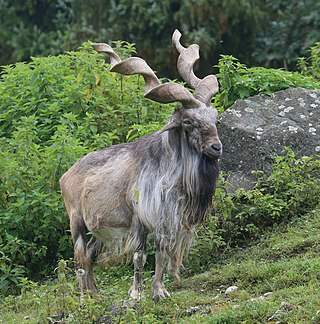
Capra is a genus of mammals, the goats, comprising ten species, including the markhor and several species known as ibexes. The domestic goat is a domesticated species derived from the wild goat. Evidence of goat domestication dates back more than 8,500 years.

The markhor is a large wild Capra (goat) species native to South Asia and Central Asia, mainly within Pakistan, the Karakoram range, parts of Afghanistan, and the Himalayas. It is listed on the IUCN Red List as Near Threatened since 2015.
The Naltar Wildlife Sanctuary is a protected area located in the Naltar Valley near Nomal, in Gilgit-Baltistan, Pakistan. The Sanctuary was created on 22 November 1975 and consists of a steep-sided forested valley with high mountains on either side. A small number of Astor markhor are found here as well as other large mammals.
Afghanistan has long been known for diverse wildlife. Many of the larger mammals in the country are categorized by the International Union for Conservation of Nature (IUCN) as globally threatened. These include the snow leopard, Marco Polo sheep, Siberian musk deer, markhor, urial, and the Asiatic black bear. Other species of interest are the ibex, the gray wolf, and the brown bear, striped hyenas, and numerous bird of prey species. Most of the Marco Polo sheep and ibex are being poached for food, whereas wolves, snow leopards and bears are being killed for damage prevention.

The Siberian ibex, also known using regionalized names including Altai ibex,Asian ibex, Central Asian ibex, Gobi ibex, Himalayan ibex, Mongolian ibex or Tian Shan ibex, is a polytypic species of ibex, a wild relative of goats and sheep. It lives in Central Asia, and is, by far, the most widely-distributed species in the genus Capra. In terms of population stability, Siberian ibex are currently ranked as Near Threatened, mostly due to over-hunting, low densities and overall decline; still, reliable data is minimal and difficult to come by, in addition to the animals’ expansive natural range, so accurate observations are still scant. The Siberian ibex has, formerly, been treated as a subspecies of the Eurasian Alpine ibex, and whether or not it is a single species or a complex of distinct units that stand out as genetically-distinct is still not entirely clear. The Siberian ibex is the longest and heaviest member of the genus Capra, though its shoulder height is slightly surpassed by the markhor.

Chitral Gol National Park is one of the National Parks of Pakistan. It is located in Lower Chitral District in Khyber-Pakhtunkhwa province of Pakistan beside the Chitral River, at a distance of two hours drive from Chitral town. The park is also known as Chitral National Park.
Dashkin is a village in Astore, Pakistan. It is 85 km from Gilgit, the capital of Gilgit-Baltistan. It has over 5,000 inhabitants, primarily farmers and herdsmen.

The wildlife of Pakistan comprises a diverse flora and fauna in a wide range of habitats from sea level to high elevation areas in the mountains, including 195 mammal, 668 bird species and more than 5000 species of Invertebrates. This diverse composition of the country's fauna is associated with its location in the transitional zone between two major zoogeographical regions, the Palearctic, and the Oriental. The northern regions of Pakistan, which include Khyber Pakhtunkhwa and Gilgit Baltistan include portions of two biodiversity hotspot, Mountains of Central Asia and Himalayas.
The Astor markhor or flare-horned markhor is a subspecies of the markhor, native to Kashmir and northern Pakistan. To the west it reaches the easternmost parts of Afghanistan. The range of the Astor markhor is very scattered. At one time considered an "endangered species", conservation efforts have had some success and the largest subpopulation in Pakistan may now exceed 1000 individuals. As a result, the International Union for Conservation of Nature has rated its status as "near-threatened".

The Bukharan markhor, or Tadjik markhor is an endangered goat-antelope, native to Tajikistan, Turkmenistan and Uzbekistan, possibly also Afghanistan. Today it is found in few scattered populations, for example in Kugitang Nature Reserve in easternmost Turkmenistan. The population of the Bukharan markhor is at around 5,750 animals.

The Girgentana is an Italian breed of domestic goat indigenous to the province of Agrigento, in the southern part of the Mediterranean island of Sicily. The name of the breed derives from Girgenti, the name of Agrigento in local Sicilian language. There were in the past more than 30,000 head in the hills and coastal zone of the province. Today, however, this breed is in danger of disappearance.
Köýtendag Nature Reserve, formerly Kugitang Nature Reserve, is a nature reserve (zapovednik) in the extreme east of Turkmenistan.
Ramit State Nature Reserve is situated in Tajikistan north east of Dushanbe. It consist of 16139 ha mountains and forests.
The Sulaiman markhor or straight-horned markhor is a goat endemic to Asia. It is a subspecies of Capra falconeri. Scientists differ regarding whether it is the same subspecies as the Kabul markhor.

The Kashmir markhor, Pir Panjal markhor, or flare-horned markhor is a possible subspecies of Capra falconeri endemic to the Western Himalayas of India and Pakistan. Many, including the IUCN, do not consider it a separate subspecies.








